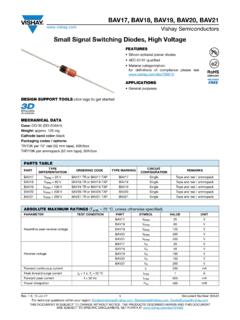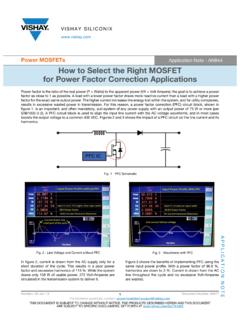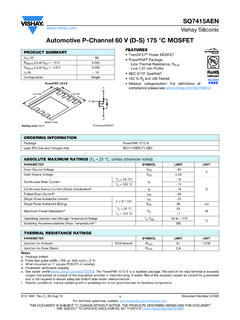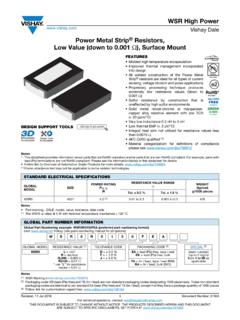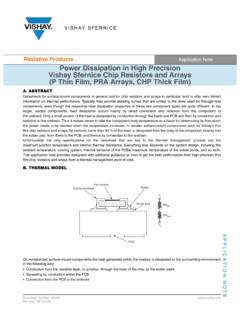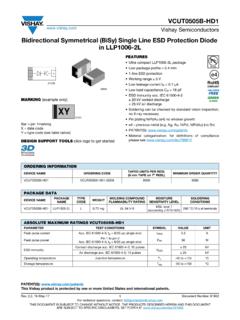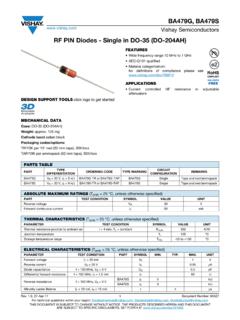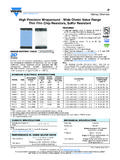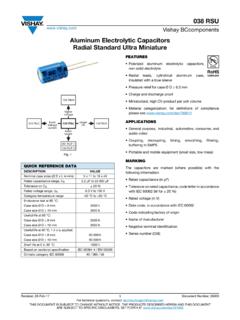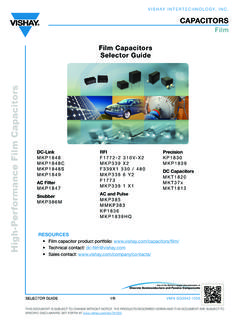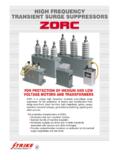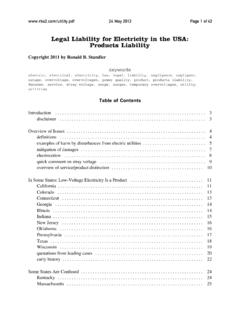Transcription of Transient Voltage Suppressors (TVS) for Automotive ...
1 Document Number: 88490 For technical questions within your region, please contact one of the : GENERAL SEMICONDUCTORT ransient Voltage SuppressorsApplication NoteTransient Voltage Suppressors (TVS) for Automotive electronic ProtectionAPPLICATION NOTEBy Soo Man (Sweetman) Kim,Senior Application ManagerA major challenge in Automotive design is protectingelectronics - such as control units, sensors, andentertainment systems - against damaging surges, voltagetransients, ESD, and noise that are present on the powerline. Transient Voltage Suppressors (TVS) are ideal solutionsfor Automotive electronic protection and have severalimportant parameters for these applications, includingpower rating, stand-off Voltage , breakdown Voltage , andmaximum breakdown Voltage . Following are definitions forthese ratingThe power rating of a TVS is its surge-absorbing capabilityunder specific test or application conditions.
2 The industrial-standard test condition of 10 s/1000 s pulse form(Bellcore 1089 spec.), as shown in Figure 1. This testcondition differs from the TVS ESD test condition of8 s/20 s pulse form, as shown in Figure 2. Fig. 1 - Test Waveform of TVS Fig. 2 - Test Waveform of TVS ESDB reakdown Voltage (VBR)The breakdown Voltage is the Voltage at which the devicegoes into avalanche breakdown, and is measured at aspecified current on the Breakdown Voltage (VC: Clamping Voltage )The clamping Voltage appears across the TVS at thespecified peak pulse current rating. The breakdown voltageof a TVS is measured at a very low current, such as 1 mAor 10 mA, which is different from the actual avalanchevoltage in application conditions. Thus, semiconductormanufactures specify the typical or maximum breakdownvoltage in large Voltage (VWM): Working Stand-Off ReverseVoltageThe stand-off Voltage indicates the maximum Voltage of theTVS when not in breakdown, and is an important parameterof protection devices in circuits that do not operate undernormal conditions.
3 In Automotive applications, someregulation of the Automotive electronics is provided by jump-start protection . This condition supplies 24 VDC in10 min to 12 V type electronics, and 36 VDC in 10 min to24 V type electronics without damage or malfunction of thecircuit. Thus, the stand-off Voltage is one of the keyparameters in TVS for Automotive %100 %50 %(ms)10 s/1000 s051020250 %100 %50 %( s)8 sIPPM1528 s/20 sIPPMT ransient Voltage Suppressors (TVS) for Automotive electronic Protection technical questions within your region, please contact one of the following:Document Number: 09-Aug-10 Application NoteVishay General SemiconductorAPPLICATION NOTE Fig. 3 - Parameters of Voltage and CurrentPRIMARY PROTECTION OF THE Automotive POWER LINE (LOAD DUMP) Automotive electronics, such as electronic control units,sensors, and entertainment systems, are connected to onepower line.
4 The power sources for these electronics are thebattery and alternator, both of which have unstable outputvoltages that are subject to temperature, operating status,and other conditions. Additionally, ESD, spike noise, andseveral kinds of Transient and surge voltages are introducedinto the power and signal line from Automotive systems thatuse solenoid loads, such as fuel injection, valve, motor,electrical, and hydrolytic controllers. Fig. 4 - Typical Vehicle Power BusWhat is Load Dump?The worst instances of surge Voltage are generated whenthe battery is disconnected when the engine is in operation,and the alternator is supplying current to the power line ofthe vehicle. This condition is known as load dump , andmost vehicle manufacturers and industry associationsspecify a maximum Voltage , line impedance, and timeduration for this load dump status, as shown in Figure 5. Fig. 5 - Output Voltage of Alternator in Load Dump ConditionTwo well-known tests simulate this condition: the sISO-7637-2 pulse 5 and Japan s JASO A-1 for 14 Vpowertrains and JASO D-1 for 27 V powertrains.
5 In thissection we review the application of TVS for load dump in14 V and Results of Load Dump TestsThe s ISO-7637-2 pulse 5 and Japan s JASO A-1 testsfor 14 V powertrains are simulated in Table ..BatteryRegulatorESD or LightningHigh Voltage inducedby AlternatorReaction Transientfrom Motor and Spark PlugsALoadXOutput Voltage of AlternatorBatteryConnectedBatteryDisconn ectedVPVNTABLE 1 - MAJOR LOAD DUMP TEST CONDITIONS FOR 14 V POWERTRAINSV TOTAL (VP)(V)VS(V)VA(V)Ri( )TIME(ms)CYCLE TIMEJASO 7637-2 pulse to to to Voltage Suppressors (TVS) for Automotive electronic ProtectionApplication NoteVishay General SemiconductorAPPLICATION NOTE Document Number: 88490 For technical questions within your region, please contact one of the : Fig. 6 - For ISO-7637-2 Test Conditions, the Standard Condition is a VS Range of 65 V to 87 V, and Ri (Line Impedance) Range of to 4 Some vehicle manufactures apply different conditions forthe load dump test based on ISO-7637-2 pulse 5.
6 The peakclamped current of the load dump TVS will be estimated bythe following equation:Calculation for peak clamping currentFigure 6a shows the current and Voltage waveforms ofVishay s SM5S24A in the ISO 7637-2 test of 87 V VS, VVbatt., Ri and 400 ms pulse 6a - Clamped Voltage and Current of SM5A24 Ain ISO 7637-2 TestFigure 6b shows the clamped Voltage and current of loaddummp TVF fail in the ISO 7637-2 test of 87 V VS, VVbatt., Ri and 400 ms pulse width. The clampingvoltage drops to near zero, and the current passed throughthe device is increased to the maximum allowed by the 6b - Clamped Voltage and Current of Load Dump TVSF ailures in ISO7637-2 TestMaximum clamping capability of vishay load dump TVS ofISO 7637-2 pulse 5 test condition with V Vbatt. and400 ms pulse width is as Figure 6c - Maximum Clamping Capability of vishay Load Dump TVS in ISO7637-2 Test010020040050(ms)300 Line Impedance and Pulse DurationJASO A-1: , 200 msISO-7637: min.
7 ( to 4 ), 400 ms max. (40 ms to 400 ms)(V)ISO 7637Vr + 10 % of VSJASO % of VPVPVSVr1000 IPPVinVc ()Ri =IPP: Peak clamping currentVin: Input voltageVc: Clamping voltageRi: Line impedanceTransient Voltage Suppressors (TVS) for Automotive electronic Protection technical questions within your region, please contact one of the following:Document Number: 09-Aug-10 Application NoteVishay General SemiconductorAPPLICATION NOTETwo Groups of Load Dump TVST here are two kinds of load dump TVS for the primaryprotection of Automotive electronics: EPI PAR TVS andNon-EPI PAR TVS. Both product groups have similaroperating breakdown characteristics in reverse bias difference is that EPI-PAR TVSs have low forwardvoltage drop (VF) characteristics in forward mode, andnon-EPI PAR TVSs have relatively high VF under the sameconditions.
8 This characteristic is important to the reversevoltage supplied to the power line. Most CMOS ICs and LSIshave very poor reverse Voltage gates of MOSFETs are also weak in reverse Voltage , at- 1 V or lower. In the reversed power input mode, the voltageof the power line is the same as the Voltage of the TVS reverse bias mode causes electronic circuit failure. Thelow forward Voltage drop of EPI PAR TVSs is a good solutionto this problem. Another method to protect circuits fromreversed power input is utilizing a polarity protection rectifierinto the power line, as shown in Figure 7. A polarityprotection rectifier should have sufficient forward currentratings, and forward surge and reverse Voltage capabilities. Fig. 7 - Reverse Bias StatusSECONDARY PROTECTION OF THE Automotive POWER LINEThe primary target of protection circuits in automotivesystems is high surge voltages, but the clamped Voltage isstill high.
9 Secondary protection is especially important in24 V powertrains, such as found in trucks and vans. Themain reason for this is the maximum input voltages for mostregulators and DC/DC converter ICs for automotiveapplications are 45 V to 60 V. For this kind of application,using secondary protection, as shown in Figure 8, isrecommended. Fig. 8 - Secondary Protection CircuitAdding resistor R onto the power line reduces thetransient current, allowing smaller power-rating TVSs as thesecondary protection. Current requirements formicroprocessor and logic circuits in electronic units are150 mA to 300 mA, and the minimum output Voltage of a12 V battery is V at - 18 C, or V for a 24 V batteryunder the same conditions. In a 24 V battery under theabove conditions, the supply Voltage at a 300 mA load is at R = 20 , and V at R = 10 at a minimum voltageof battery of V (24 V battery Voltage in - 18 C).
10 Power rating of R = I2 RThis supply Voltage is higher than the minimum inputvoltages for most Voltage regulators and DC/DC Input+LoadCurrent LimiterPrimaryProtection+ () () ()R () =VL: Voltage to loadVmin.: Minimum input Voltage IL: Load currentR: Resistor valu
